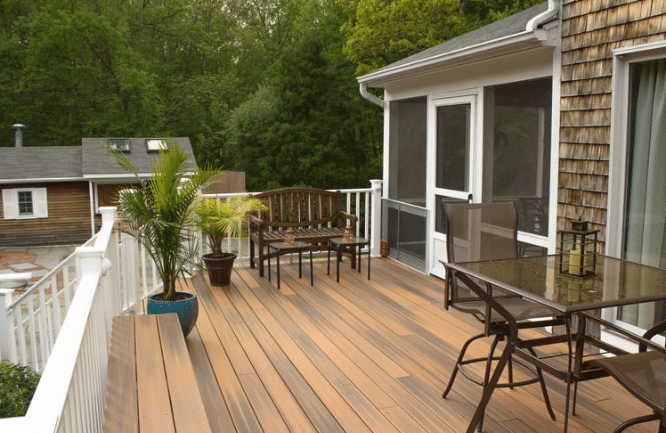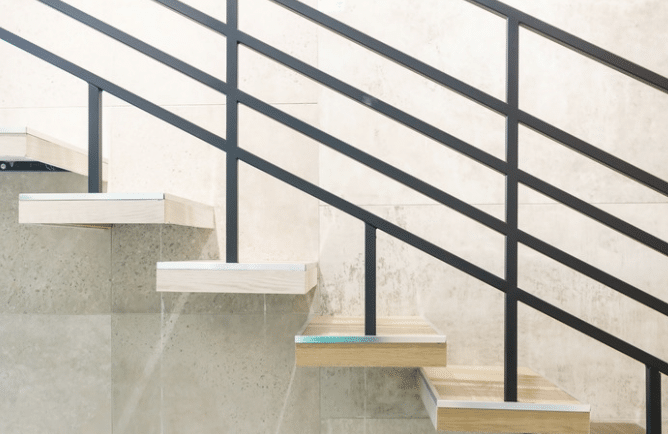Discover the best types of handrails for outdoor steps. Learn about materials, styles, and safety features to enhance outdoor space!
Safety and beauty go hand in hand when designing or updating outdoor steps. A handrail does more than offer support. It helps prevent falls, guides movement, and adds style to your walkway or porch. With so many options, knowing the best types of handrails for outdoor steps can make your decision easier.
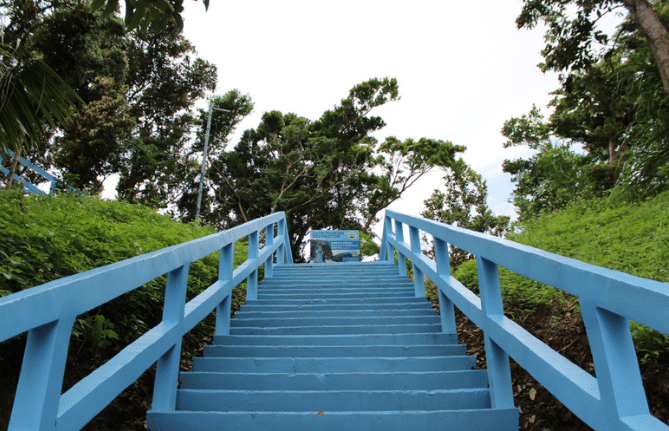
This guide covers the best materials and styles for outdoor handrails, including wood, metal, vinyl, and composite. We share the pros of each, from weather resistance to low maintenance. Whether you’re a homeowner or builder, this simple guide will help you choose the right handrail for your steps.
Why Are Handrails Important for Outdoor Steps
Before diving into the types of handrails for outdoor steps, it’s essential to understand their importance:
1. Safety
Handrails help you keep your balance when using stairs. They are invaluable when it’s rainy, icy, or the steps are slippery. Holding onto a handrail can stop you from slipping. Adding a strong handrail is a good way to keep everyone safe.
2. Accessibility
Handrails make stairs easier for everyone to use. Kids, older people, and those with trouble walking can use them for support. They make going up or down the stairs safer. Adding a handrail is a simple way to make your home safer for everyone.
3. Compliance
Many building rules say you need a handrail if your steps are high. This helps keep people safe. Putting in a handrail protects your family and enables you to follow safety rules. It also helps you pass building checks without any problems.
4. Aesthetics
A good-looking handrail can make your home look nicer. It can match your home’s design and make your stairs more welcoming. Whether you choose wood, metal, or glass, the right handrail adds style and helps improve your home’s appearance.
1. Wooden Handrails
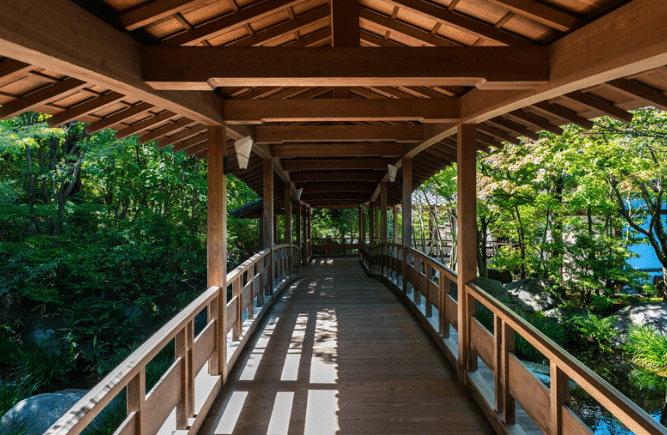
Wooden handrails are a classic choice, offering a warm, natural look that blends seamlessly with outdoor environments.
Pros:
- Aesthetic Appeal: Wood provides a timeless, rustic, or modern look depending on the finish.
- Customizable: Easily shaped, carved, or stained to match your design preferences.
- Comfortable Grip: Smooth texture makes it comfortable to hold.
Cons:
- Maintenance: Requires regular sealing or painting to prevent rot, warping, and insect damage.
- Durability: Less resistant to extreme weather compared to metal or composite options.
Best For:
In traditional homes, decks, and garden steps, aesthetics are a priority.
2. Metal Handrails
Metal handrails are among the most durable types of handrails for outdoor steps, with options like aluminum, wrought iron, and stainless steel.
Pros:
- Strength & Longevity: Resistant to weathering, rust (if properly treated), and heavy use.
- Low Maintenance: Requires minimal upkeep compared to wood.
- Modern Look: Ideal for contemporary and industrial-style designs.
Cons:
- Heat Retention: Metal can become hot in direct sunlight.
- Hard Surface: Less comfortable to grip than wood or vinyl.
Best For:
High-traffic areas, commercial properties, and modern homes.
3. Vinyl/PVC Handrails
Vinyl handrails are a practical, low-maintenance option among the types of handrails for outdoor steps.
Pros:
- Weatherproof: Resistant to moisture, UV rays, and temperature fluctuations.
- Easy to Clean: Simply wipe down with soap and water.
- Affordable: Generally cheaper than wood or metal.
Cons:
- Less Aesthetic: Can look artificial compared to natural materials.
- Durability Issues: May crack or fade over time in extreme climates.
Best For:
Budget-friendly projects and coastal areas with high humidity.
4. Cable Handrails
Cable handrails offer a sleek, minimalist design, making them a popular modern choice.
Pros:
- Unobstructed Views: Thin cables provide safety without blocking scenery.
- Durable: Stainless steel cables resist corrosion and wear.
- Low Maintenance: Requires occasional tightening but no painting or sealing.
Cons:
- Not Ideal for All Users: Thin cables may not provide enough grip for children or elderly individuals.
- Installation Complexity: Requires precise tensioning for safety.
Best For:
Modern homes, decks, and waterfront properties are where visibility is key.
5. Glass Handrails
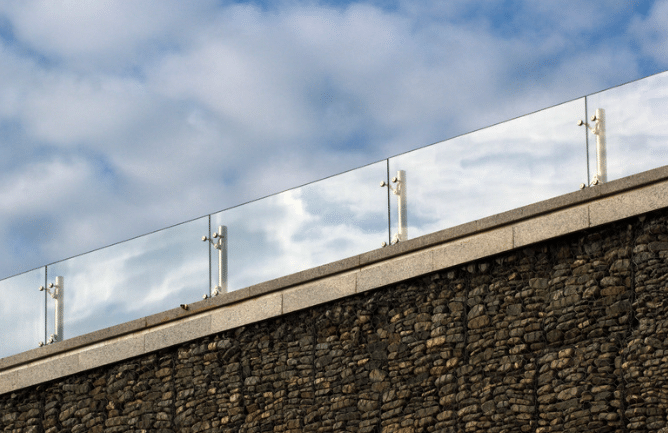
For a high-end, contemporary look, glass handrails are an excellent choice.
Pros:
- Elegant Appearance: Provides a luxurious, unobstructed view.
- Weather-Resistant: Tempered glass withstands harsh conditions.
- Easy to Clean: Wipe with glass cleaner for a spotless finish.
Cons:
- Expensive: Higher cost than most other types of handrails for outdoor steps.
- Fragility Risk: While tempered glass is strong, it can still crack under extreme impact.
Best For:
Luxury homes, commercial buildings, and modern architectural designs.
6. Composite Handrails
Composite handrails combine wood fibers and plastic for a durable, low-maintenance alternative.
Pros:
- Eco-Friendly: Often made from recycled materials.
- No Rot or Splintering: Resists moisture, insects, and UV damage.
- Wood-Like Appearance: Mimics the look of wood without the upkeep.
Cons:
- Cost: More expensive than vinyl but cheaper than high-end wood or metal.
- Limited Color Options: Fewer customization choices compared to wood.
Best For:
Homeowners who want a wood-like appearance without maintenance hassles.
7. Pipe Handrails
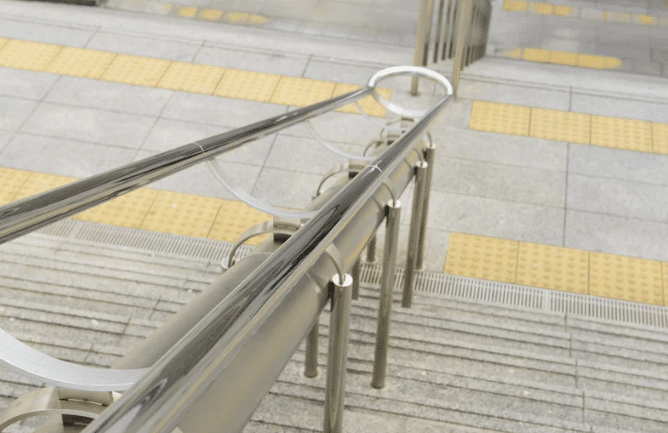
Commonly used in industrial and commercial settings, pipe handrails are sturdy and functional.
Pros:
- Extreme Durability: Can withstand heavy use and harsh conditions.
- Simple Design: Works well in utilitarian and industrial spaces.
Cons:
- Basic Aesthetics: Lacks decorative appeal compared to wrought iron or wood.
- Cold to Touch: Uncomfortable in freezing temperatures.
Best For:
Industrial buildings, public spaces, and areas requiring heavy-duty support.
Choosing the Right Handrail for Your Outdoor Steps
When selecting from the various types of handrails for outdoor steps, consider the following factors:
1. Climate
Pick strong materials that can handle the weather if you live where it rains or snows a lot. Aluminum, metal, or composite work well. These don’t rust or rot easily and will last long, even in harsh weather conditions.
2. Budget
Think about how much you want to spend. Vinyl and wood are cheaper and still look nice. If you have more money, glass and wrought iron give a fancier look. Choose a railing that fits your style and your budget.
3. Maintenance
Some materials are easier to care for than others. Metal, vinyl, and composite don’t need much cleaning or painting. They last longer without a lot of work. These are good if you don’t want to spend time fixing or cleaning your stair railing often.
4. Aesthetics
Pick a railing that looks good in your home, with modern glass and metal. Wood gives a warm and classic feel. Wrought iron looks fancy and strong. The right look helps your stairs match the rest of your home and feel well put together.
5. Safety Requirements
Make sure your stair railing follows local safety rules. It should be the right height, have a good grip size, and the spaces between posts should not be too broad. This keeps everyone safe and helps your home pass building checks.
Installation Tips for Outdoor Handrails
Proper installation ensures safety and longevity. Here are key tips:
1. Secure Mounting
Always use strong brackets and anchors when putting up a stair handrail. This is very important for steps made of concrete or brick to keep the railing steady. A secure handrail helps everyone feel safe going up or down the stairs.
2. Correct Height
Make sure your stair railing is at the right height. The common height is between 34 to 38 inches from the front of the step. This makes it easier for people to hold onto the rail and follow safety rules.
3. Smooth Edges
Look closely at the handrail for any rough or sharp spots. Use sandpaper or a file to smooth them out. This stops people from getting scratched or hurt, especially children or anyone using the rail often.
4. Professional Help
If you’re using tricky materials like glass, cable, or metal, it’s best to call a pro. They know how to install these safely and correctly. This makes sure your stair handrail works well and lasts a long time.
Frequently Asked Questions
What is the best material for outdoor handrails?
Metal, such as aluminum or stainless steel, is the best material for outdoor handrails because it resists rust and lasts a long time. Vinyl and treated wood are also good choices. Choose a material that can handle weather changes and stay strong and safe.
What is the alternative to stair handrails?
Alternatives to stair handrails include side walls, glass panels, cable rails, or half-walls. These options still help with safety but offer a more modern or open look. Even with these choices, many building codes still require at least one stair handrail.
Which type of stair railing is best?
The best stair railing depends on your style and needs. Wood railings look classic and warm. Metal railings are strong and modern, while glass and cable railings give a clean, open feel. Choose one that matches your home and meets safety rules for height and grip.
Do external steps need a handrail?
Yes, most outdoor steps need a handrail if there are four or more steps. This is for safety and is often required by local building codes. Even if not required, adding a handrail can help prevent slips, especially in rain, snow, or icy weather.
Do I need a handrail on the outside of the stairs?
You need a handrail outside the stairs if the stairway has several steps, usually four or more. Rules vary by area, but outdoor stairs are safer with a handrail. It helps people keep balance and prevents falls, especially during bad weather.
Conclusion
Choosing the right handrail adds safety and charm to any outdoor space. With many options available, knowing the best types of handrails for outdoor steps helps you make a smart and stylish choice. A well-picked handrail improves curb appeal and gives peace of mind every day.
Strong and weather-ready handrails are a smart investment. Whether you choose wood, vinyl, or metal, the goal is always the same: safe steps and lasting beauty. If you’re unsure where to start or need help, we also offer trusted gate repair services to complete your outdoor project easily.
Rolling Gates cares about safety and design. From handrails to gates, we handle every job with skill and care. Call us today at 888-588-1470 for expert help, friendly service, and honest advice. Let us help you create a safer, better outdoor space for your home.
End Note
Improve the look and safety of your home or business with custom solutions from Rolling Gates. We design and install stair handrails that fit your space and style. We also install gate openers and offer gate repairs in San Mateo County for smooth, secure entry.
See our past projects in the gallery to explore the quality of our work, from gates to stair railings. Visit our blog for helpful tips and updates. Follow us on Facebook, Instagram, and X. Check Yelp to read what our happy customers say about our service.
Start your project today by visiting our contact page. From your first call to the finished job, we keep everything simple and clear. Whether it’s a repair or a new install, our team is ready to deliver long-lasting strong, safe, and clean results.
Rolling Gates
Walnut Creek, CA 94596
+18885881470


